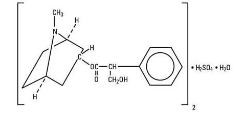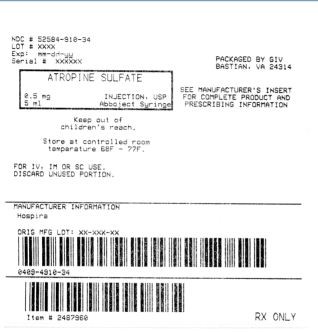Atropine Sulfate
General Injectables & Vaccines, Inc.
Atropine Sulfate 0.5mg 5ml Abboject Syringe
FULL PRESCRIBING INFORMATION: CONTENTS*
- Clinical Pharmacology Section
- Indications & Usage Section
- Contraindications
- Warnings
- Precautions
- Side Effects
- Overdosage
- Dosage and Administration
- How Supplied
- Storage
- Sample Outer Package Label
FULL PRESCRIBING INFORMATION
Atropine Sulfate Injection, USP is a sterile, nonpyrogenic isotonic solution of atropine sulfate monohydrate in water for injection with sodium chloride sufficient to render the solution isotonic. It is administered parenterally by subcutaneous, intramuscular or intravenous injection.
Each milliliter (mL) contains atropine sulfate, monohydrate 0.1mg (adult strength) or 0.05mg (pediatric strength), and sodium chloride, 9mg. May contain sodium hydroxide and/or sulfuric acid for pH adjustment 0.308 mOsmol/mL (calc.) pH 4.2 (3.0 to 6.5).
Atropine sulfate Injection is a parenteral anticholinergic agent and muscarinic antagonist.

Clinical Pharmacology Section
Atropine is commonly classified as an anticholinergic or antiparasympathetic (parasympatholytic)
drug. More precisely, however, it is termed an antimuscarinic agent since it antagonizes the
muscarine-like actions of acetyl-choline and other choline esters.
Atropine inhibits the muscarinic actions of acetylcholine on structures innervated by
postganglionic cholinergic nerves, and on smooth muscles which respond to endogenous
acetylcholine but are not so innervated. As with other antimuscarinic agents, the major action of
atropine is a competitive or surmountable antagonism which can be overcome by increasing the
concentration of acetylcholine at receptor sites of the effector organ (e.g., by using
anticholinesterase agents which inhibit the enzymatic destruction of acetylcholine). The receptors
antagonized by atropine are the peripheral structures that are stimulated or inhibited by muscarine
(i.e., exocrine glands and smooth and cardiac muscle). Responses to postganglionic cholinergic
nerve stimulation also may be inhibited by atropine but this occurs less readily than with responses
to injected (exogenous) choline esters.
Atropine-induced parasympathetic inhibition may be preceded by a transient phase of
stimulation, especially on the heart where small doses first slow the rate before characteristic
tachycardia develops due to paralysis of vagal control. Atropine exerts a more potent and prolonged
effect on heart, intestine and bronchial muscle than scopolamine, but its action on the iris, ciliary
body and certain secretory glands is weaker than that of scopolamine. Unlike the latter, atropine in
clinical doses does not depress the central nervous system but may stimulate the medulla and
higher cerebral centers. Although mild vagal excitation occurs, the increased respiratory rate and
(sometimes) increased depth of respiration produced by atropine are more probably the result of
bronchiolar dilatation. Accordingly, atropine is an unreliable respiratory stimulant and large or
repeated doses may depress respiration.
Adequate doses of atropine abolish various types of reflex vagal cardiac slowing or asystole.
The drug also prevents or abolishes bradycardia or asystole produced by injection of choline esters,
anticholinesterase agents or other parasympathomimetic drugs, and cardiac arrest produced by
stimulation of the vagus. Atropine also may lessen the degree of partial heart block when vagal
activity is an etiologic factor. In some patients with complete heart block, the idioventricular rate
may be accelerated by atropine; in others, the rate is stabilized. Occasionally a large dose may
cause atrioventricular (A-V) block and nodal rhythm.
Atropine Sulfate Injection, USP in clinical doses counteracts the peripheral dilatation and
abrupt decrease in blood pressure produced by choline esters. However, when given by itself,
atropine does not exert a striking or uniform effect on blood vessels or blood pressure. Systemic
doses slightly raise systolic and lower diastolic pressures and can produce significant postural
hypotension. Such doses also slightly increase cardiac output and decrease central venous pressure.
Occasionally, therapeutic doses dilate cutaneous blood vessels, particularly in the “blush” area
(atropine flush), and may cause atropine “fever” due to suppression of sweat gland activity in
infants and small children.
Atropine disappears rapidly from the blood following injection and is distributed throughout the
body. Much of the drug is destroyed by enzymatic hydrolysis, particularly in the liver; from 13 to
50% is excreted unchanged in the urine. Traces are found in various secretions, including milk.
Atropine readily crosses the placental barrier and enters the fetal circulation.
Sodium chloride added to render the solution isotonic for injection of the active ingredient is
present in amounts insufficient to affect serum electrolyte balance of sodium (Na+) and chloride
(Cl¯ ) ions.
Indications & Usage Section
Atropine Sulfate Injection, USP is indicated (1) as an antisialogogue for preanesthetic medication
to prevent or reduce secretions of the respiratory tract, (2) to restore cardiac rate and arterial
pressure during anesthesia when vagal stimulation produced by intra-abdominal surgical traction
causes a sudden decrease in pulse rate and cardiac action, (3) to lessen the degree of
atrioventricular (A-V) heart block when increased vagal tone is a major factor in the conduction
defect as in some cases due to digitalis, (4) to overcome severe bradycardia and syncope due to a
hyperactive carotid sinus reflex, (5) as an antidote (with external cardiac massage) for
cardiovascular collapse from the injudicious use of a choline ester (cholinergic) drug, (6) in the
treatment of anticholinesterase poisoning from organophosphorus insecticides, and (7) as an
antidote for the “rapid” type of mushroom poisoning due to the presence of the alkaloid, muscarine,
in certain species of fungus such as Amanita muscaria.
Contraindications
Atropine generally is contraindicated in patients with glaucoma, pyloric stenosis or prostatic
hypertrophy, except in doses ordinarily used for preanesthetic medication.
Warnings
Atropine is a highly potent drug and due care is essential to avoid overdosage, especially with
intravenous administration. Children are more susceptible than adults to the toxic effects of
anticholinergic agents.
Precautions
Do not administer unless solution is clear and seal is intact. Discard unused portion.
Atropine Sulfate Injection, USP should be used with caution in all individuals over 40 years of
age. Conventional systemic doses may precipitate acute glaucoma in susceptible patients, convert
partial organic pyloric stenosis into complete obstruction, lead to complete urinary retention in
patients with prostatic hypertrophy or cause inspissation of bronchial secretions and formation of
dangerous viscid plugs in patients with chronic lung disease.
Pregnancy Category C. Animal reproduction studies have not been conducted with atropine. It
also is not known whether atropine can cause fetal harm when given to a pregnant woman or can
affect reproduction capacity. Atropine should be given to a pregnant woman only if clearly needed.
Side Effects
Most of the side effects of atropine are directly related to its antimuscarinic action. Dryness of the
mouth, blurred vision, photophobia and tachycardia commonly occur with chronic administration
of therapeutic doses. Anhidrosis also may occur and produce heat intolerance or impair temperature
regulation in persons living in a hot environment. Constipation and difficulty in micturition may
occur in elderly patients. Occasional hypersensitivity reactions have been observed, especially skin
rashes which in some instances progressed to exfoliation.
Adverse effects following single or repeated injections of atropine are most often the result of
excessive dosage. These include palpitation, dilated pupils, difficulty in swallowing, hot dry skin,
thirst, dizziness, restlessness, tremor, fatigue and ataxia. Toxic doses lead to marked palpitation,
restlessness and excitement, hallucinations, delirium and coma. Depression and circulatory collapse
occur only with severe intoxication. In such cases, blood pressure declines and death due to
respiratory failure may ensue following paralysis and coma.
Overdosage
In the event of toxic overdosage (See ADVERSE REACTIONS), a short acting barbiturate or
diazepam may be given as needed to control marked excitement and convulsions. Large doses for
sedation should be avoided because central depressant action may coincide with the depression
occurring late in atropine poisoning. Central stimulants are not recommended. Physostigmine,
given as an atropine antidote by slow intravenous injection of 1 to 4 mg (0.5 to 1.0 mg in children),
rapidly abolishes delirium and coma caused by large doses of atropine. Since physostigmine is
rapidly destroyed, the patient may again lapse into coma after one to two hours, and repeated doses
may be required. Artificial respiration with oxygen may be necessary. Ice bags and alcohol sponges
help to reduce fever, especially in children.
The fatal adult dose of atropine is not known; 200 mg doses have been used and doses as high
as 1000 mg have been given.
In children, 10 mg or less may be fatal. With a dose as low as 0.5 mg, undesirable minimal
symptoms or responses of overdosage may occur. These increase in severity and extent with larger
doses of the drug (excitement, hallucinations, delirium and coma with a dose of 10 mg or more).
Dosage and Administration
Atropine Sulfate Injection, USP may be administered subcutaneously, intramuscularly
or intravenously. The average adult dose is 0.5 mg (5 mL of a 0.1 mg/mL solution), range 0.4 to
0.6 mg (4 to 6 mL). As an antisialogogue it is usually injected intramuscularly prior to induction of
anesthesia. This produces only minimal blocking of vagal activity. In children, the dosage ranges
from 0.1 mg (2 mL of a 0.05 mg solution) in the newborn to 0.6 mg (6 mL of a 0.1 mg/mL
solution) in a child age 12 years, injected subcutaneously 30 minutes before surgery. During
surgery, the drug is given intravenously when reduction in pulse rate and cessation of cardiac action
are due to increased vagal activity; however, if the anesthetic is cyclopropane, doses less than
0.4 mg should be used and should be given slowly to avoid the possible production of ventricular
arrhythmia. Usual doses are used to reduce severe bradycardia and syncope associated with
hyperactive carotid sinus reflex. For bradyarrhythmias the usual intravenous adult dosage ranges
from 0.4 to 1 mg (4 to 10 mL of a 0.1 mg/mL solution) every one to two hours as needed; larger
doses up to a maximum of 2 mg may be required. In children, intravenous dosage ranges from
0.01 to 0.03 mg (0.2 to 0.6 mL of a 0.05 mg/mL solution) per kg of body weight. Atropine is also a
specific antidote for cardiovascular collapse resulting from injudicious administration of choline
ester. When cardiac arrest has occurred, external cardiac massage or other method of resuscitation
is required to distribute the drug after intravenous injection.
In anticholinesterase poisoning from exposure to insecticides, large doses of at least 2 to 3 mg
(20 to 30 mL of a 0.1 mg/mL solution) should be administered parenterally and repeated until signs
of atropine intoxication appear. In the “rapid” type of mushroom poisoning, atropine should be
given in doses sufficient to control parasympathomimetic signs before coma and cardiovascular
collapse supervene.
Parenteral drug products should be inspected visually for particulate matter and discoloration
prior to administration, whenever solution and container permit. See PRECAUTIONS.
How Supplied
Atropine Sulfate Injection, USP is supplied in single-dose containers as follows:
| List No. |
Needle |
Size |
Conc. |
Total Content(Atropine) |
|
|
|
|
|
|
|
|
|
|
|
|
|
|
|
|
|
|
|
|
|
|
|
|
| Lifeshield Abboject Unit of Use Syringe with make luer lock adapter and protected needle |
|
|
|
|
| 4910 |
20-G |
5mL |
0.1mg/mL (Adult) |
0.5mg |
| 4911 |
20-G |
10mL |
0.1mg/mL (Adult) |
1mg |
Storage
Store at 20 to 25°C (68° to 77°F). [See USP Controlled Room Temperature.]
Revised: February, 2007
Sample Outer Package Label

Atropine SulfateAtropine Sulfate INJECTION, SOLUTION
| |||||||||||||||||||||||||||||||||||||||||||||||||||||||||||||